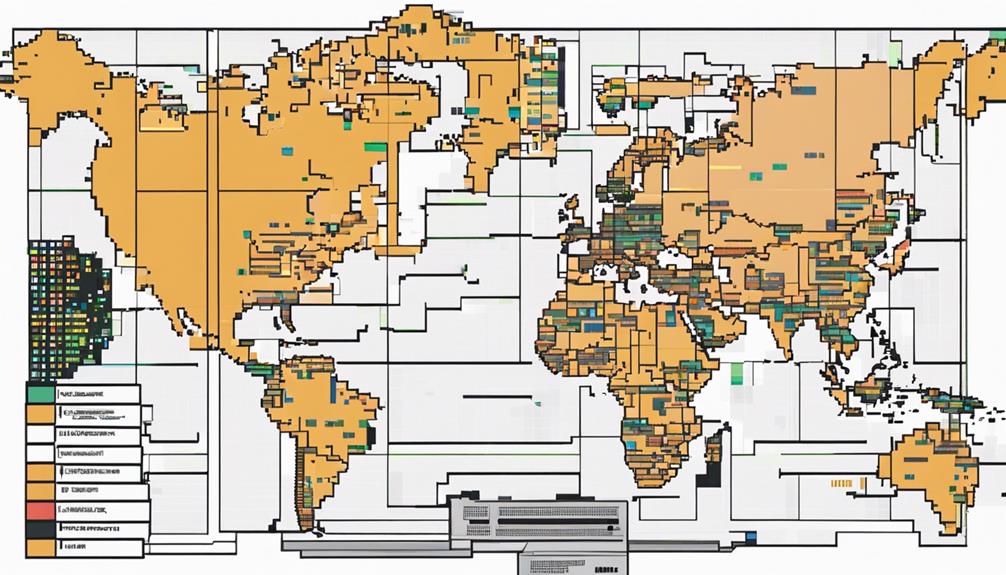Efficient allocation of satellite network bandwidth and frequencies is a cornerstone in ensuring seamless global communication. The intricacies of spectrum management and frequency coordination play a pivotal role in optimizing data transmission capabilities across vast distances. From regulatory frameworks to technological advancements, a deeper exploration into the complexities of bandwidth allocation unveils a world where precision and innovation converge to meet the ever-growing demands of modern connectivity. The strategic orchestration of satellite resources holds the key to unlocking a future where communication knows no bounds.
Key Takeaways
- Satellite frequency allocation crucial for bandwidth optimization.
- Spectrum efficiency techniques enhance network performance.
- Various frequency bands cater to diverse satellite applications.
- Interference mitigation strategies improve bandwidth allocation.
Satellite Network Bandwidth Overview

The Satellite Network Bandwidth Overview delves into the fundamental capacity for data transmission facilitated by satellites. Satellite frequency plays a critical role in this process, as it determines the range of frequencies within the electromagnetic spectrum that can be utilized for communication. The frequency spectrum allocated for satellite communication is carefully managed to avoid interference and maximize efficiency.
Satellites operate within specific frequency bands allocated by international regulatory bodies to ensure seamless communication and coordination among different satellite systems. These frequency allocations are essential for avoiding signal interference and maintaining the integrity of communication links. By adhering to allocated frequency bands, satellite operators can optimize their network performance and ensure reliable data transmission.
Efficient utilization of the frequency spectrum is crucial for meeting the increasing demands for satellite communication services. Bandwidth allocation principles must be designed to support various applications, such as television broadcasting, internet connectivity, and remote sensing. By carefully managing the satellite frequency spectrum, operators can achieve optimal communication efficiency and deliver high-quality services to users worldwide.
Frequency Allocation Basics
In the realm of satellite communication systems, the fundamental cornerstone lies in the strategic allocation of frequencies to optimize data transfer efficiency and minimize interference. This process is crucial for ensuring seamless communication between satellites and ground stations. Here are some key aspects regarding frequency allocation in satellite communications:
- ITU Coordination: Frequency allocation in satellite communications is coordinated by the International Telecommunication Union (ITU), a specialized agency of the United Nations. The ITU plays a vital role in managing and assigning frequency bands to satellite operators worldwide.
- Spectrum Optimization: Satellite operators often share or reuse frequency bands to optimize spectrum usage. By efficiently utilizing the available frequency spectrum, operators can enhance the overall capacity and performance of satellite communication systems while minimizing the risk of signal interference.
- Band Allocation: The ITU allocates different frequency bands such as L-band, S-band, and C-band for specific satellite communication services. Each frequency band has unique characteristics and is suitable for different types of satellite applications, ranging from broadcasting to broadband communication.
- Resource Management: Satellite frequency bands are valuable resources that require effective management to ensure global coverage and reliable transmission. Adapting frequency band allocations based on market demands and environmental factors is essential for maintaining the quality and sustainability of satellite communication services.
Efficient frequency allocation is essential for the smooth operation of satellite networks and plays a critical role in meeting the growing demands for satellite communication services worldwide.
Regulatory Considerations in Allocation

Regulatory oversight in satellite frequency allocation encompasses critical considerations for ensuring efficient spectrum management and equitable access among operators globally. Global Frequency Allocation is a complex process overseen by regulatory bodies such as the International Telecommunication Union (ITU) to ensure fair and efficient use of the limited spectrum resources available for satellite communication. This process involves allocating specific frequency bands for uplink and downlink services, taking into account spectrum efficiency to maximize the utilization of the available spectrum.
To better understand the regulatory considerations in satellite frequency allocation, a table highlighting key aspects can be useful:
| Regulatory Considerations | Description |
|---|---|
| ITU Guidelines | Regulatory bodies like the ITU provide guidelines for spectrum allocation globally. |
| Spectrum Efficiency | Allocation decisions prioritize spectrum efficiency to enhance overall spectrum management. |
| Operator Sharing | Spectrum is allocated in a manner that allows equitable sharing among satellite operators. |
| Resource Management | Spectrum and orbit resources are managed carefully due to their limited availability and value. |
| Fair Access | Adherence to regulatory guidelines ensures fair access to spectrum resources for all operators. |
Technical Challenges in Bandwidth Allocation
Addressing the intricate technical challenges inherent in bandwidth allocation for satellite networks requires a meticulous understanding of network dynamics and service demands. Efficient spectrum usage is crucial due to the limited availability of frequency bands for satellite communication. Dynamic network structures pose challenges for allocating bandwidth effectively in satellite systems. Bandwidth allocation principles must address the diverse requirements of different satellite communication applications. Effective bandwidth allocation strategies ensure optimal utilization of available frequency resources in satellite networks.
When dealing with technical challenges in bandwidth allocation for satellite networks, the following key considerations come into play:
- Limited Frequency Bands: Due to the scarcity of frequency bands allocated for satellite communication, efficient utilization is paramount to meet the demands of various services and users.
- Dynamic Network Structures: The ever-changing nature of network configurations and traffic patterns poses a challenge in allocating bandwidth effectively, requiring adaptive strategies.
- Diverse Application Requirements: Different satellite communication applications have varying needs, necessitating tailored bandwidth allocation approaches to ensure optimal performance.
- Optimizing Spectrum Usage: Maximizing the use of available spectrum resources through advanced allocation techniques is essential for enhancing overall network efficiency and capacity.
Satellite Frequency Band Applications

Efficient utilization of satellite frequency bands is integral to supporting a wide array of applications, with each band designated for specific uses ranging from mobile communications to radar systems. The allocation of frequency bands plays a crucial role in optimizing the performance of satellite communication systems. Different frequency bands cater to diverse needs and applications within the satellite communication domain.
The higher bands such as Ku, Ka, and Q/V bands are known for their versatility in supporting various services. These bands facilitate a broad spectrum of applications ranging from broadband services to radar systems. Ku band, for instance, is widely used for satellite broadcasting and broadband internet services. Ka band finds applications in high-throughput satellite communication systems, including broadband access and military communications. The Q/V band is utilized for experimental purposes, satellite communication research, and high-data-rate applications.
Furthermore, the lower frequency bands like L Band, S Band, C Band, and X Band also serve specific purposes in satellite communication systems. For instance, L Band is crucial for satellite mobile phones and GPS carriers. S Band is commonly employed in weather and ship radars, along with certain NASA communication satellites. C Band is predominantly allocated for satellite television networks and data services. X Band, on the other hand, is primarily utilized by the military for radar and monitoring applications. Each frequency band's unique characteristics and applications contribute to the efficient operation of satellite communication systems.
Maximizing Spectrum Efficiency
Maximizing spectrum efficiency in satellite communication is essential for achieving optimal data transfer rates. Spectrum sharing strategies, interference mitigation techniques, and dynamic frequency allocation are key points to consider in this endeavor. Efficient spectrum management plays a critical role in enhancing network performance and capacity, ensuring effective communication reach and throughput.
Spectrum Sharing Strategies
Spectrum sharing strategies play a crucial role in enhancing the utilization of frequencies by enabling operators to share or reuse allocated spectrum efficiently. To maximize spectrum efficiency, operators implement the following strategies:
- Dynamic Spectrum Sharing: Allows operators to dynamically access underutilized frequencies to meet varying demands.
- Licensed Shared Access (LSA): Enables shared access to licensed spectrum, increasing its utilization without causing interference.
- Cognitive Radio Technology: Utilizes intelligent radios to adapt frequency use based on real-time spectrum availability.
- Geolocation Databases: Facilitate spectrum sharing by providing information on available frequencies in specific locations, optimizing spectrum utilization.
These strategies ensure efficient spectrum allocation, enabling operators to meet the increasing demand for data transmission effectively.
Interference Mitigation Techniques
Utilizing adaptive power control techniques is essential in satellite networks to minimize signal interference and enhance overall spectral efficiency. Frequency bands in satellite communication are limited and valuable, making interference mitigation techniques crucial. By implementing strategies such as spatial isolation, polarization diversity, and interference cancellation algorithms, satellite networks can maximize spectrum efficiency. Advanced modulation techniques like QPSK and 16QAM also play a significant role in reducing signal-to-noise ratio requirements, further optimizing bandwidth utilization. Additionally, beamforming technology enables satellites to focus signals directionally, reducing interference from other directions. Employing these interference mitigation techniques enhances the quality and reliability of satellite communication links, ensuring efficient utilization of the available frequency bands.
| Interference Mitigation Techniques | Benefits | Examples |
|---|---|---|
| Adaptive Power Control | Minimize signal interference | Power adjustment |
| Spatial Isolation | Reduce interference from neighboring satellites | Antenna placement |
| Polarization Diversity | Enhance signal quality and reliability | Cross-polarization |
| Advanced Modulation Techniques | Optimize bandwidth utilization | QPSK, 16QAM |
| Interference Cancellation Algorithms | Improve overall link quality | Signal processing |
Dynamic Frequency Allocation
Dynamic frequency allocation in satellite networks is a critical mechanism for optimizing spectrum efficiency and adapting to changing network requirements. When it comes to maximizing spectrum efficiency, dynamic frequency allocation plays a vital role by adjusting frequency bands based on evolving network demands. Here are key points to consider:
- It optimizes the use of limited frequency resources to enhance network performance and capacity.
- Adaptive frequency allocation strategies ensure that available spectrum is efficiently utilized in real time.
- Dynamic frequency allocation allows for flexible allocation based on varying user needs and network conditions.
- By dynamically reallocating frequency bands, satellite networks can adapt to fluctuations in demand and maintain optimal performance levels.
Incorporating dynamic frequency allocation is essential for ensuring efficient communication services, especially in higher frequency bands.
Spectrum Sharing Mechanisms
Spectrum sharing mechanisms, such as Dynamic Spectrum Access and Cognitive Radio Technology, are pivotal in optimizing the utilization of frequency bands among satellite operators. These dynamic approaches enable efficient sharing of scarce spectrum resources, fostering enhanced capacity and reduced interference in satellite communications. The implementation of these mechanisms aligns with ITU regulations to ensure equitable and effective management of satellite frequency bands for the benefit of all stakeholders involved.
Dynamic Spectrum Access
Efficient allocation of frequency resources through adaptive sharing mechanisms is crucial for optimizing spectrum utilization in satellite networks. Dynamic Spectrum Access (DSA) plays a vital role in enabling this efficiency by allowing for flexible sharing of spectrum resources among multiple users. Here are key points about DSA:
- DSA facilitates dynamic allocation of frequencies based on demand.
- Spectrum sharing mechanisms like Cognitive Radio adaptively adjust frequency use to prevent interference.
- DSA promotes spectrum efficiency by maximizing the use of available frequencies.
- Opportunistic access to spectrum, enabled by DSA, enhances network capacity and overall performance.
Through DSA, satellite networks can achieve better spectrum utilization, improved performance, and increased capacity.
Cognitive Radio Technology
Cognitive radio technology, a sophisticated spectrum sharing mechanism, empowers secondary users to access underutilized spectrum bands while ensuring minimal disruption to primary users. By incorporating spectrum sensing and decision-making capabilities, cognitive radios can effectively detect and adapt to changes in the radio frequency (RF) environment. This dynamic spectrum access technique enhances communication systems by enabling the intelligent selection of available frequencies, thereby optimizing spectrum utilization in real-time. The utilization of cognitive radio technology not only maximizes spectrum efficiency but also promotes coexistence between different types of users, fostering a more flexible and resilient communication network. Through its ability to intelligently navigate and utilize the spectrum, cognitive radio technology plays a crucial role in enhancing overall communication performance.
Interference Mitigation Strategies

To ensure optimal performance and reliability of satellite networks, implementing effective interference mitigation strategies is crucial in maintaining signal integrity and maximizing bandwidth utilization. In the realm of satellite communications, interference can arise from various sources such as neighboring satellites, terrestrial transmitters, or even atmospheric conditions. Here are some key interference mitigation strategies:
- Frequency Coordination: Proper frequency coordination is essential to prevent signal overlap and interference within the satellite spectrum. By allocating frequencies carefully and ensuring that neighboring satellites or ground stations operate on non-interfering frequencies, the likelihood of signal degradation due to interference is significantly reduced.
- Power Control: Employing techniques like power control enables satellites to adjust their transmission power dynamically. This adaptive approach helps in mitigating interference by regulating the signal strength based on the received signal quality, thereby minimizing the impact of unwanted signals.
- Advanced Modulation Schemes: Utilizing advanced modulation schemes enhances the resilience of satellite communications against interference. By encoding information more efficiently and robustly, these schemes improve the overall link performance even in the presence of interfering signals.
- Spatial Diversity Techniques: Techniques like beamforming leverage spatial diversity to combat interference effectively. By focusing signal energy in specific directions and utilizing multiple antennas to enhance reception, satellite systems can improve signal quality and reliability amidst interference challenges.
Future Trends in Frequency Allocation
Future trends in frequency allocation are witnessing a shift towards higher frequency bands such as the Ka-band, driven by the need for advanced communication services. Spectrum sharing strategies, challenges in integrating 5G technology, and the evolving regulatory policies are key focal points in shaping the future of frequency allocation for satellite networks. As demands for broadband services escalate, the development of dynamic spectrum sharing techniques and the design of satellites with flexible frequency allocation capabilities are crucial for meeting the evolving communication requirements.
Spectrum Sharing Strategies
Efficient spectrum sharing strategies are crucial for optimizing frequency allocation among multiple operators and enhancing spectrum utilization to meet the growing demand in communication networks. When it comes to spectrum sharing in satellite systems and beyond, several key strategies are emerging:
- Dynamic Spectrum Sharing: Utilizing cognitive radio technology for adaptive frequency selection.
- Coexistence Mechanisms: Developing protocols for harmonious spectrum sharing between satellite systems and terrestrial networks.
- Regulatory Frameworks: Implementing policies to ensure fair access to shared frequencies and encourage innovation.
- Collaborative Spectrum Management: Facilitating cooperation between operators to maximize spectrum efficiency and meet diverse communication needs.
These strategies pave the way for improved spectrum utilization and efficient allocation in satellite communication systems.
5G Integration Challenges
In the realm of satellite network bandwidth and frequency allocation, the emergence of 5G Integration Challenges signifies a pivotal shift towards addressing the harmonization obstacles between terrestrial 5G networks and satellite systems. The integration of new technologies like 5G into satellite services poses significant challenges in Radio Frequency (RF) spectrum management. Spectrum sharing mechanisms are being explored to optimize frequency allocation for both 5G terrestrial networks and satellite communication systems. Dynamic spectrum access models are under development to facilitate efficient sharing of frequencies among different communication technologies. Coexistence studies play a crucial role in ensuring the seamless integration of 5G services with existing satellite communication systems. As the landscape evolves, addressing these integration challenges becomes paramount for the future of satellite communication systems.
Regulatory Policy Evolution
How are evolving regulatory policies shaping the future trends in frequency allocation for satellite communication systems? The landscape of frequency allocation for satellite technology is undergoing significant transformations driven by regulatory policy evolution. To understand the direction of this evolution, consider the following key points:
- Increased Spectrum Demand: Growing demand for spectrum by satellite communication systems is steering regulatory bodies towards exploring innovative frequency allocation strategies.
- Spectrum Sharing: Regulatory bodies like the ITU are investigating spectrum sharing and dynamic spectrum access to optimize frequency allocation for satellite networks.
- Technological Advancements: Advances in satellite technology are necessitating regulatory policy changes to accommodate new services and applications that rely on specific frequency bands.
- Efficiency and Innovation: Regulatory frameworks are adapting to promote efficient spectrum use, reduce interference, and stimulate innovation in satellite communication systems.
These trends highlight the importance of regulatory policies in shaping the future of frequency allocation for satellite communication systems.
Satellite Network Bandwidth Security
Ensuring the security of satellite network bandwidth involves implementing robust encryption techniques and advanced technologies to protect data transmission integrity and confidentiality. Secure satellite communication protocols such as Virtual Private Networks (VPNs) and secure tunneling protocols play a vital role in safeguarding data during transmission over satellite networks. Encryption is a fundamental aspect of securing satellite communications, as it ensures that data remains confidential and cannot be intercepted by unauthorized entities. Additionally, technologies like frequency hopping and spread spectrum are employed to enhance security by making it difficult for unauthorized users to intercept signals and access sensitive information.
To further understand the aspects of satellite network bandwidth security, the following table outlines key measures and technologies utilized in securing satellite communications:
| Security Measure | Description | Implementation |
|---|---|---|
| Encryption Techniques | Utilized to secure data transmission, ensuring confidentiality and integrity of data. | AES encryption, RSA encryption |
| Frequency Hopping Technology | Technique that changes the frequency of a signal rapidly to prevent interception. | FHSS (Frequency Hopping Spread Spectrum) technology |
| Secure Communication Protocols | Protocols like VPNs and secure tunneling used to establish secure communication channels. | IPsec, SSL/TLS |
| Continuous Monitoring | Essential for detecting and preventing security breaches or vulnerabilities. | Intrusion Detection Systems (IDS), Security Audits |
| Access Control | Regulations and mechanisms limiting access to authorized users only. | User authentication, Access Control Lists (ACLs) |
Global Coordination in Spectrum Allocation

Securing the efficient use of frequency bands for satellite communication, global coordination in spectrum allocation overseen by organizations such as the ITU ensures fair access and optimal spectrum efficiency across operators worldwide. This coordination is crucial in managing the allocation of frequency bands to different satellite communication services. Here are four key aspects of global coordination in spectrum allocation:
- ITU Regulations: The ITU plays a central role in developing international regulations and agreements regarding the allocation of frequency bands for satellite communication. These regulations aim to harmonize spectrum use globally, facilitating interoperability and minimizing interference between satellite systems.
- Shared Spectrum: Operators share and reuse frequencies within allocated bands to maximize spectrum efficiency. By sharing spectrum, multiple operators can coexist within the same frequency bands, increasing the overall capacity and utilization of the spectrum for satellite communication services.
- Global Coverage: Specific frequency bands are allocated for satellite communication to ensure global coverage and consistent service delivery. Allocating bands such as L, S, and C band for satellite communication enables operators to provide services across vast geographical areas, including remote regions.
- Fair Access: Global coordination in spectrum allocation ensures fair access for all countries and operators, promoting equitable distribution of spectrum resources. This equitable distribution is essential for enabling connectivity and communication services on a global scale, benefiting both developed and developing nations.
Advancements in Spectrum Allocation Technology
Facilitating enhanced spectrum utilization, recent technological advancements in spectrum allocation have revolutionized the efficiency of frequency band utilization for satellite communication networks. These advancements have introduced innovative techniques that optimize the use of frequency bands, leading to more effective satellite communication services. Dynamic spectrum sharing enables multiple operators to efficiently utilize the same frequency bands, increasing overall spectrum efficiency. Cognitive radio technology allows satellites to adapt their frequency usage in real-time based on demand, ensuring optimal utilization of available frequencies. Moreover, software-defined radio systems play a crucial role in maximizing spectrum usage for different satellite communication services by enabling flexible and programmable frequency allocation.
The following table highlights key advancements in spectrum allocation technology that have significantly improved frequency band utilization for satellite communication networks:
| Advancements in Spectrum Allocation Technology |
|---|
| Dynamic Spectrum Sharing |
| Cognitive Radio Technology |
| Software-Defined Radio Systems |
These technologies collectively contribute to the effective management of frequency bands, ensuring that satellite networks operate efficiently and meet the growing demands for spectrum allocation. By harnessing these advancements, satellite communication networks can enhance performance, increase capacity, and support a wider range of services across various frequency bands.
Managing Spectrum Allocation Costs

Optimizing spectrum allocation costs is a critical aspect of managing efficient satellite networks, considering the diverse factors influencing the overall expenditure. When it comes to managing spectrum allocation costs for satellite communications, several key considerations play a vital role:
- Frequency Bands: The choice of frequency bands significantly impacts allocation costs. High-demand bands such as the Ka-band may incur higher expenses due to limited availability and increased usage.
- Licensing Fees: Obtaining licenses for specific frequency bands involves costs that contribute to the overall spectrum allocation expenses.
- Coordination Costs: Coordinating with other satellite operators and regulatory bodies to ensure interference-free operation can lead to additional expenses in spectrum allocation.
- Spectrum Acquisition Expenses: Acquiring additional spectrum or expanding existing allocations to meet coverage requirements can incur substantial costs, affecting the overall budget for satellite network operations.
Efficient spectrum management practices are essential for reducing allocation costs while maintaining optimal network performance and coverage. Balancing the financial aspects of spectrum allocation with the technical requirements of satellite communications is crucial in achieving cost-effective and reliable satellite network operations.
Frequently Asked Questions
What Is the Frequency Allocation for Satellite System?
Satellite coverage is reliant on meticulous spectrum management to ensure optimal communication reach and network performance. Frequency allocation for satellite systems is a critical aspect of this process, with specific bands like L, S, C, X, Ku, Ka, and Q/V designated for diverse applications such as mobile communications, TV broadcasting, data services, radar, and military operations. These allocations are essential for enabling reliable and global transmission of data through satellite networks.
What Frequency Band Does Satellite Use?
Satellite technology relies on a diverse range of frequency bands to facilitate communication services, ensuring seamless data transmission across vast distances. The frequency spectrum allocation for satellites encompasses bands like L, S, C, X, Ku, Ka, and Q/V, each serving specific purposes within the realm of satellite communication. Understanding the frequency band that satellites utilize is crucial for optimizing network performance and ensuring reliable connectivity in various applications.
What Is the Bandwidth of Satellites?
Satellite coverage is critical for various applications, with bandwidth optimization being a key factor in ensuring efficient data transmission. The bandwidth of satellites refers to the range of frequencies available for communication, dictating the amount of data that can be transmitted. By managing satellite bandwidth effectively, data transmission efficiency is enhanced, leading to improved network performance and capacity for services like TV broadcasting and internet access.
What Frequency Is Needed for Satellite Communication?
In satellite communication, the required frequency for optimal operation is pivotal to signal clarity, reliability, and robustness. Factors such as signal interference, power consumption, weather conditions, and signal strength play vital roles in determining the ideal frequency for seamless communication. By selecting the appropriate frequency band, satellite networks can effectively navigate through potential obstacles and deliver high-quality data transmission across vast coverage areas.
